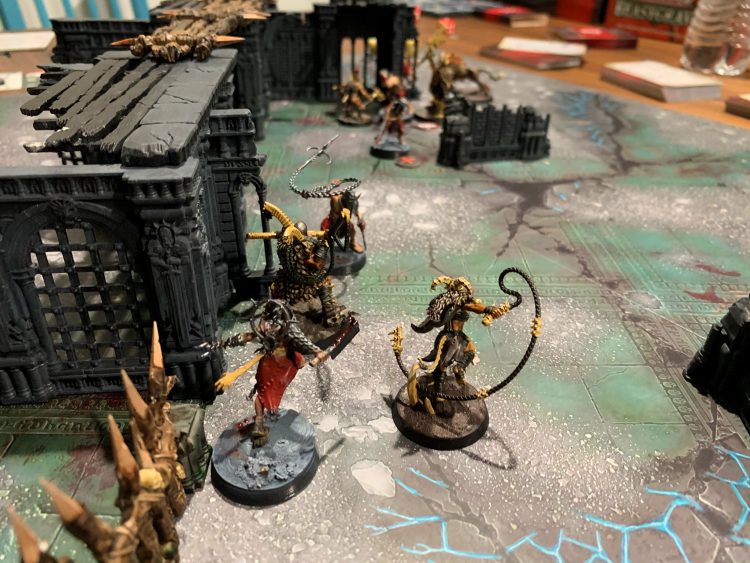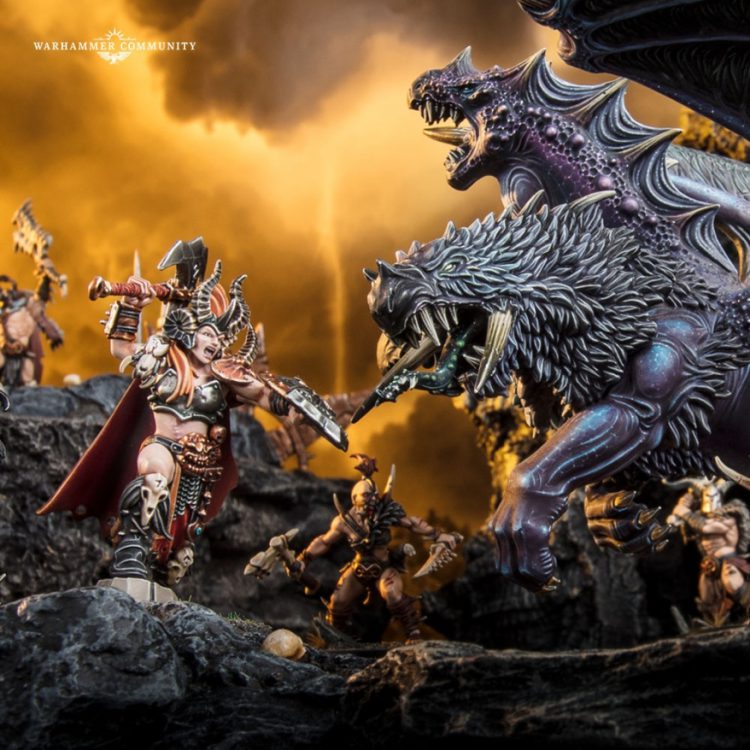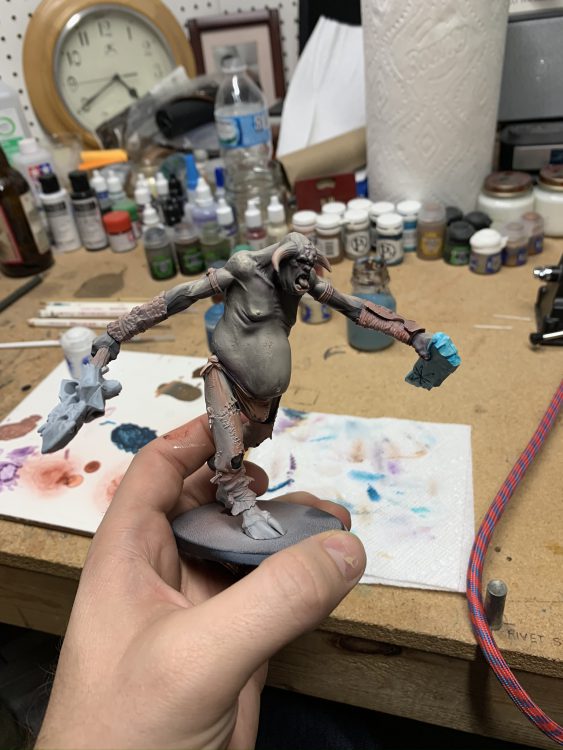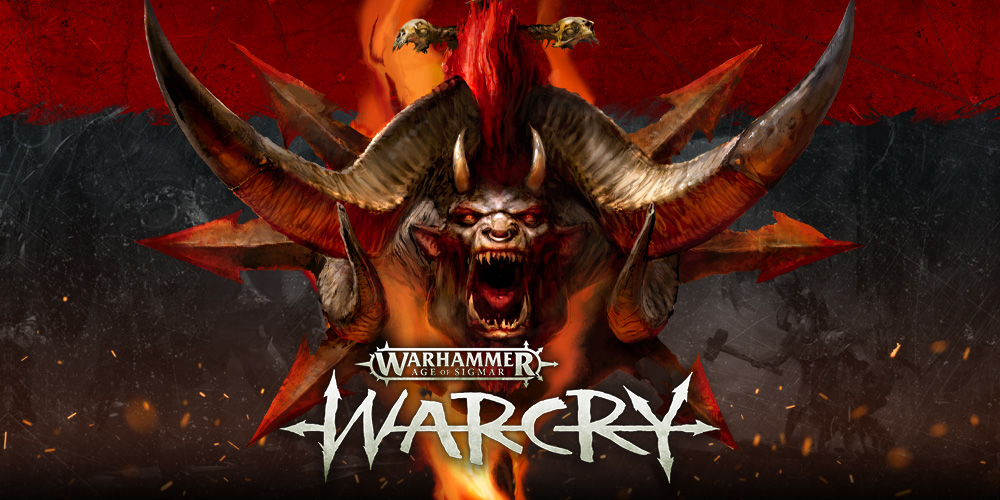One of 2019’s major Games Workshop releases was Warcry, a new skirmish game set in the Mortal Realms. In advance of its release, rumors swirled. Would it be a scaled-down version of Age of Sigmar, employing similar rules like Kill Team did, for Warhammer 40k? Would it feel like a new version of Mordheim? The reality ended up being something completely different.
Warcry represents a massive shift in design for Games Workshop’s tabletop wargames. Gone is the well-trod cadence of an I-Go-You-Go action system. Also gone are unit entries with stats like Weapon Skill, Ballistic Skill, and Armor Saves all feeding the familiar Hit/Wound/Save/Other Save sequence present in GW’s other wargame offerings. Instead, Warcry adopted a modern alternating activation system that moves along at a blistering pace. More hit points with fewer rolls make Warcry feel bloodier and faster than its larger cousins, and a brand-new setting with unique warbands gives it its own feel.

While Warcry supports both Matched-Play and tournament formats, we were particularly taken with its innovative – if simple – campaign system. Battles in a Warcry Narrative Campaign do not represent a unified story in which every player is an actor. Instead, your campaign is an individual one. It’s the story of your Warband, with battles portraying those moments where your path crossed the blood-soaked path of another warband for a brief and brutal moment. If you’ve ever participated in a Dungeons & Dragons Adventurer’s League then the idea is similar; you can take your warband to any shop and play against any opponent regardless of where you are on your campaign and still play an engaging campaign game.
While personally I love this campaign system for its simplicity and ease of getting a game in, it received some fair criticism by some that it was too stripped-down. Simply adding models and rolling on a chart for the occasional boon didn’t satisfy those looking for a richer Mordheim-esque experience. Campaigns are linear, and there is a little bit of a narrative burden placed on the players to elevate a game from a dice-chucking battlefest into a cohesive story. Well, things are changing now my friends. Two expansion books – Monsters & Mercenaries and Tome of Champions – have since been released and both deepen that narrative experience for those who are looking for it.
Monsters & Mercenaries
Ogors and Arachnids and Undead Dragons – oh my! Released in September of 2019, Monsters & Mercenaries is the first major expansion for Warcry. In addition to the titular Monsters and allied Mercenaries, this book introduces a few new concepts for Warcry campaigns. Note: while the book makes allowances for Matched Play enthusiasts to use these rules if both players agree on it, it’s clear that the focus of all of these rules is on Narrative Play modes. Open Players are also told they can use them if both players agree but Open Players can always do whatever they want so, go forth and murder my Goons.
The first new concept is known as a Fated Quest. In the Warcry core rules, each available faction has 1 or 2 unique quests it can attempt. These campaign quests represent narratively appropriate stories for each warband and culminate in an appropriate reward. Fated Quests are universal quests that can be embarked upon by any warband. Unlike the core campaigns, they end in a choice. Players can opt to earn Honour – a powerful Exalted Command Trait – or Glory – a mighty artifact. While structurally similar to the standard campaigns, these items and abilities are more powerful than the stock ones and are a welcome option for those who have finished a Core Campaign.

More exciting than these, however, are Challenge Battles. These battles serve as diversions to the campaign; one player acts as the challenger and can earn incredible rewards at the risk of losing some mid-Campaign Territory while the other packs up their personal warband and acts as the Adversary. Neither player earns campaign progress or glory; the Challenger may get to add a savage Monster to their warband while the Adversary gets the fun opportunity to control a massive Ogor or Terrorgheist and see how much damage they can do.
Because these battles don’t advance the campaign, they provide an opportunity to take a rest from the main saga and explore a new element or story of the Bloodwind Spoil. They’re the Rogue One to Star Wars’ Episode III and IV, if you will. Succeed and gain an new ally; fail and enjoy the spectacle of seeing your fighters consumed by a Chimera. Because games of Warcry are so fast, it isn’t a huge burden on the Adversary either. It’s plenty easy to plan a night where each player gets the opportunity to declare a Challenge Battle, with the results changing the landscape of the rest of the campaign.
Monsters & Mercenaries also introduces the option to add Allies to your campaign warband. While not as immediately grand an imposing as a Monster, Allies provide an opportunity to flesh out your warband or shore up some tactical holes. There are fighter cards for models from across Citadel’s range of Age of Sigmar models; from Maggotkin to Darkoath Chieftains, all the way to the entire Gloomspite Gobbapalooza.
Tome of Champions
Tome of Champions builds upon what Monsters & Mercenaries started, though owning M&M isn’t necessary to enjoy this one. It also serves as the Warcry Annual. There are new battleplans and point adjustments for Matched Players, there’s a couple new terrain deployment strategies and a Monstrous Melee battle for Open Players, and finally there are significant new options for Narrative Players.
The first major section of Tome of Champions is a number of faction specific campaigns for factions previously unrepresented in the Bloodwind Spoils. At the time of the book’s release, it wasn’t actually possible to play with factions like the Ossirich Bonereapers or Seraphon; however, as of when I’m writing this faction cards have been announced for pre-order. These campaign quests are unique to each warband and function identically to those found in the Warcry Core Rules.
A new batch of Fated Quests follows, and like the ones in Monsters & Mercenaries offer either Honor or Glory for those willing to embark upon them. Again, these boons are quite powerful. One quest tasks your warband with discovering the secrets of a legendary mountain in Ghur; if you honorably share what you learn with an ally than the knowledge he shares gives your leader a permanent +3 damage to all hits -regular and critical – for the remainder of his brutish life. Eat your heart out, Gloomspite Gitz.

Tome of Champions also adds a number of new Challenge Battles. Like the ones in Monsters & Mercenaries, these battles are an excursion from the main campaign that can result in grand spoils for your warband. Rather than battling large monsters, the Challenge Battles in Tome of Champions are all themed around the Shattered Dominion Objectives sold by Games Workshop. It’s clear that the Design Team is beginning to push the design space of Warcry with some of these battles My favorite battle sees the Challenger Warband sneaking through the lair of a Flesh-Eater Ghoul King in a series of pre-game rounds where you can steal some early treasure. Make too much noise – or answer the King’s question incorrectly – and the melee begins in earnest.
Finally, we come to the biggest change to Warcry and the one that should excite those players who were hoping for something Mordheim-esque out of this game. The Trial of Champions campaign mode is a layer of rules that can be added to any campaign quest – Fated or Standard – that ups the difficulty in exchange for greater rewards and deeper narrative crunch. When embarked on a Trial of Champions, warbands have access to better loot and unique territory options, but risk taking Critical Injuries.
Territory that warbands dominate while embarked on a Trial of Champions comes with additional benefits. Upon spending the Glory to raise a monolith and dominate a Territory, you’ll get to roll on a table that gives that territory some flavor. Perhaps your first monolith is located in the ruins or an ancient arcane settlement that rewards additional glory at the end of every battle. Alternatively, you might find yourself owning a Chaotic Nexus that provides additional Wild Dice, or even control lands that give you an immediate artifact of power.

Critical Injuries come by way of temporary or permanent debilitations. A fractured arm might reduce your strength while a broken leg will hamper your movement so long as that fighter continues to draw breath. Replacing your fighters and augmenting your warband also comes with an additional price; adding fighters requires you to spend your precious glory. Suddenly the choice of replacing your broken fighter must be balanced against the opportunity to raise a monolith. Do you permit your hobbled lieutenant to continue to fight in your name? Or do you replace him with a hale and hearty fighter and move on to new territory later? They’re tough choices but the opportunity to roll on more powerful artifact tables may be enough to push you to try a Trial of Champions.
Putting it All Together
These two books take an already great campaign system and push it into something truly special. Combining a Trial of Champions campaign with Challenge Battles can provide a rich campaign experience that should satisfy those who thought that Warcry was a little too simple. Suddenly, your fighters develop unique identifies as old Gurnak survives with a stiff limp to wield the Doomblade in battle against a Bestigor.
Warcry’s brisk playtime also gives you the opportunity to play through story beats previously relegated to a post-game accounting exercise. It’s a lot more fun to actually have to go defeat a Chimera in battle than it is to spend a few resources between games and scribble its name onto your roster. Named artifacts that you quest for inject a little bit of an RPG element to the proceedings, and further narrative options printed in White Dwarf give your group fresh diversions.
It’s worth nothing at this point that while you still don’t need anything but a single warband and some terrain, getting full use out of these books requires an expansive collection of miniatures and terrain. Battleplans for these narrative campaigns draw on buildings from all of the Warcry terrain boxes, and obviously monsters and allies are drawn from across the range of Age of Sigmar models. While terrain is easy enough to swap on the fly, reworking some of the Challenge Battle to accommodate different models will take a little work.
Whether its worth it is up to you, but I’m personally willing to give it a go. While I get that the need to have more and more models may be a tough one, I’m happy to see that Games Workshop is providing redundant uses for its range. The Darkoath Warband from Warhammer Underworlds provides all the models you need to ally in some fighters from the Monsters & Mercenaries rulebook, while a Chaos Ogre purchased for your Warcry campaign can be used with the special Underworlds scenario printed in White Dwarf! Models from across the Age of Sigmar game can also find homes in Warcry; for example, my Gloomspite Cave Squigs now have rules to act as chaotic beasts in any Warcry battle where I want to swap out my Chaos Furies.

Warcry is in a fantastic place right now. The core system is a fantastic skirmish experience that plays quickly, and these two books provide rich narrative experiences without bloating the actual play of the game. Yes, there are new rules for set-up and campaign management but actually playing the game works the same way. On top of it all, this is still just the beginning. There are 2 new Chaos Warbands (that we know about) on the horizon and some new monsters designed specifically for Warcy headed our way soon. The Bloodwind Spoil calls, and its getting louder.
We’ll be writing more about Warcry in 2020, so keep checking back for updates. And as always, if you have any questions or feedback, feel free to drop us a note in the comments below or email us at contact@goonhammer.com.


